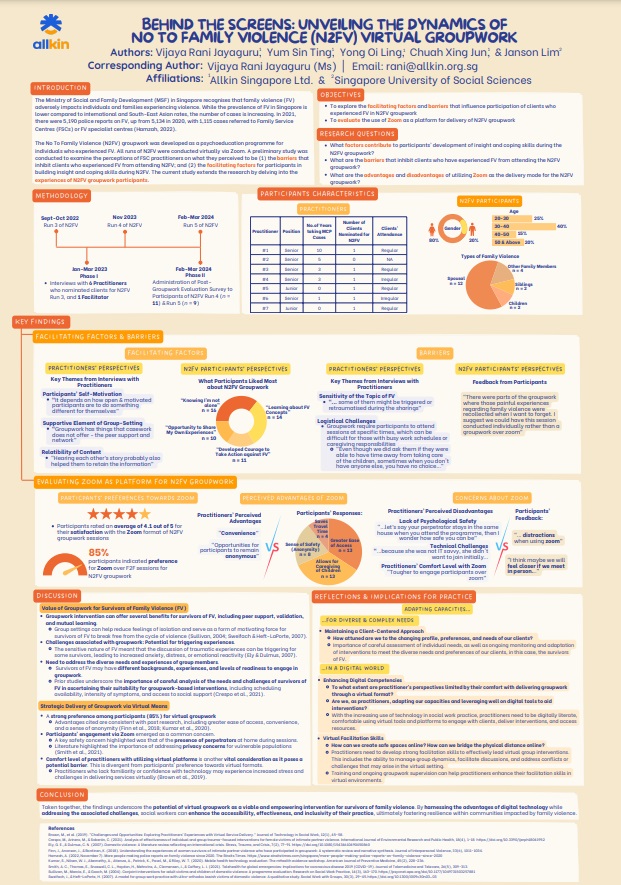Behind the Screens: Unveiling the Dynamics of No To Family Violence (N2FV) Virtual Group Work
Sin Ting Yum, Allkin Singapore Ltd, Singapore (Singapore)
Vijaya Rani Jayaguru, Allkin Singapore Ltd, Singapore (Singapore)
Oi Ling Yong, Allkin Singapore Ltd, Singapore (Singapore)
Xing Jun Chuah, Allkin Singapore Ltd, Singapore (Singapore)
Janson Lim, Singapore University of Social Sciences, Singapore (Singapore)
The No 2(To) Family Violence (N2FV) group work was developed by Allkin Singapore as a psychoeducational programme for individuals who experienced family violence and conducted virtually via Zoom. Practice research was conducted seeking social workers' and group work participants' perceptions to understand the function and dynamics of virtual group work in the context of family violence. Discussions includes researchers’ reflections on adapting group work competencies to address the diverse needs of clients.
View Poster PDF
Presentation Description:
The No 2(To) Family Violence (N2FV) group work was developed by Allkin Singapore as a psychoeducational programme for individuals who experienced family violence and receiving casework intervention support at the family service centres. All runs of N2FV were conducted virtually via Zoom. A preliminary study was conducted to examine the perceptions of social work practitioners from the family service centres on what they perceived to be (1) the barriers that inhibit their clients who experienced family violence from attending N2FV; and (2) the facilitating factors for participants in building insight and coping skills during N2FV. The current study extends the research by delving into the experiences and perceptions of N2FV group work participants. By incorporating both the practitioners’ and participants’ voices, the research seeks to enhance the overall understanding of virtual group work dynamics in the context of family violence. The ensuing discussion includes the researchers’ reflections on adapting group work competencies to address the diverse needs of clients facing family violence issues. Additionally, it explores the strategic utilization of technological means, such as Zoom, in engaging with this specific population. The multi-faceted approach presented aims to offer a comprehensive insight into the complexities of virtual group work, emphasizing the significance of integrating virtual family violence groupwork into standard survivor interventions.
References:
-
Evans, M. A., & Feder, G. S. (2015). Help-seeking amongst women survivors of domestic violence: a qualitative study of pathways towards formal and informal support. Health Expectations, 19(1), 62-73. https://doi.org/10.1111/hex.12330
-
Sweifach, J., & Heft-LaPorte, H. (2007). A model for group work practice with ultra-orthodox Jewish victims of domestic violence: A qualitative study. Social Work with Groups, 30(3), 29–45. https://doi.org/10.1300/J009v30n03_03
-
Toseland, Ronald W., & Rivas, Robert F.. (2014.). An introduction to group work practice (7th ed.). NY: Pearson.

